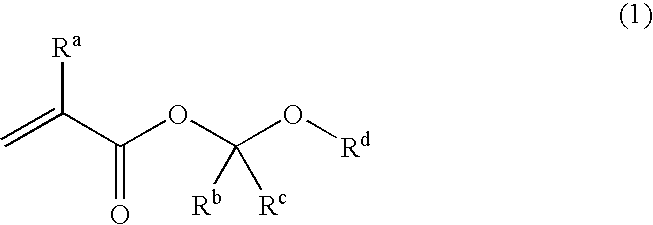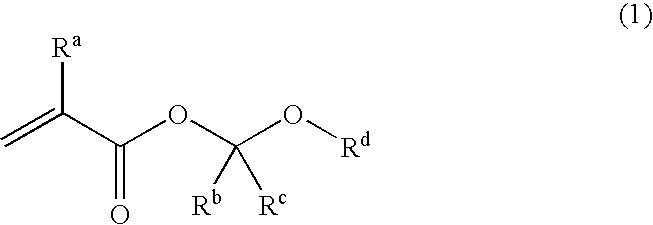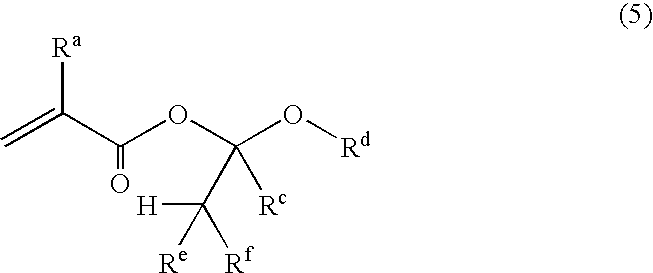Unsaturated carboxylic acid hemicacetal ester, polymeric compound and photoresist resin composition
a technology of unsaturated carboxylic acid and hemicacetal ester, which is applied in the direction of photosensitive materials, instruments, photomechanical equipment, etc., can solve the problems of insufficient balance of substrate adhesion, etching resistance and acid-eliminating function, and insufficient sensitivity or developing quality of conventional resist resins having these units, etc., to achieve superior acid-eliminating function, superior acid-eliminating function, superior effect of acid-elimin
- Summary
- Abstract
- Description
- Claims
- Application Information
AI Technical Summary
Benefits of technology
Problems solved by technology
Method used
Image
Examples
production example 1
[0173] A mixture of 21.3 g (0.118 mol) of 2-vinyloxy-4-oxatricyclo[4.2.1.03,7]nonane-5-on represented by the following formula (10), 50.8 g (0.59 mol) of methacrylic acid, 120 mg (12 mmol) of phosphoric acid, 15 mg (0.12 mmol) of 4-methoxyphenol and 210 ml of toluene were placed in 4-necked flask and stirred at 20° C. for 6 hours under nitrogen atmosphere. After the reaction, the reaction mixture was washed respectively twice by 200 ml of 10 weight % sodium carbonate aqueous solution and once by 200 ml of 10 weight % salt aqueous solution and then the organic layers were concentrated under reduced pressure. The concentrated residue was purified by silicagel column chromatography and 25.5 g (96 mmol, yield 81%) of 2-(1-methacryloyloxyethoxy)-4-oxatricyclo[4.2.1.03,7]nonane-5-on represented by the following formula (12) was obtained. This product is a mixture of two sorts of isomers and its ratio is about 1:1. In addition, 2-vinyloxy-4-oxatricyclo[4.2.1.03,7]nonane-5-on represented by...
production example 2
[0175] In a reaction vessel equipped Dean-Stark apparatus and a thermo meter, 85 g (500 mmol) of 3-hydroxy-1-oxaspiro[4.5]decane-2-on represented by the following formula (13), 31.8 g (300 mmol) of sodium carbonate and 600 ml of toluene were added and heated to 100° C. under nitrogen atmosphere while stirring. 3.36 g (5 mmol) of Ir2Cl2(C8H12)2 [di-μ-chlorobis(1,5-cyclooctadiene)diiridium(I)] was placed in a reaction vessel and then, while 100 g (1 mol) of vinyl propionate was dropped within two hours, the reaction was performed by heating and refluxing to remove water in azeotropy. After dropping the reaction was continued for more three hours. After the reaction the reaction mixture was cooled by standing, washed by 700 ml of water and concentrated under reduced pressure. By distilling the concentrated residue to purify, 22.5 g (114 mmol, 23%) of colorless and transparent liquid 3-vinyloxy-1-oxaspiro[4.5]decane-2-on represented by the formula (14) was obtained. In addition, 3-hydro...
production example 3
[0180] A mixture of 43.2 g of adamantane ethanol, 48.1 g of vinyl propionate, 15.3 g of sodium carbonate, 120 ml of toluene and 1.62 g of di-μ-chlorobis(1,5-cyclooctadiene)diiridium (I) was placed in a four-necked flask and stirred for 4 hours under nitrogen atmosphere while heating at 100° C. Precipitates in reaction mixture were filtered and the filtrate was concentrated under reduced pressure. The concentrated mixture was purified by reduced-pressure distillation and 34.8 g of 2-(adamantane-1-yl)ethylvinylether represented by the following formula (16) was obtained.
Spectral data of 2-(adamantane-1-yl)ethylvinylether
[0181]1H-NMR (CDCl3) δ: 1.46(t, 2H), 1.53 (d, 6H), 1.62-1.72 (m, 6H), 1.95(m, 3H), 3.73(t,2H), 3.96 (m,1H), 4.16 (m, 1H), 6.46 (m, 1H)
PUM
| Property | Measurement | Unit |
|---|---|---|
| carbon number | aaaaa | aaaaa |
| carbon number | aaaaa | aaaaa |
| temperature | aaaaa | aaaaa |
Abstract
Description
Claims
Application Information
 Login to View More
Login to View More - R&D
- Intellectual Property
- Life Sciences
- Materials
- Tech Scout
- Unparalleled Data Quality
- Higher Quality Content
- 60% Fewer Hallucinations
Browse by: Latest US Patents, China's latest patents, Technical Efficacy Thesaurus, Application Domain, Technology Topic, Popular Technical Reports.
© 2025 PatSnap. All rights reserved.Legal|Privacy policy|Modern Slavery Act Transparency Statement|Sitemap|About US| Contact US: help@patsnap.com



